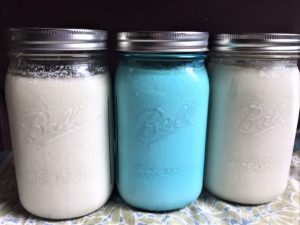Last Updated on February 13, 2022
Homemade yogurt is an incredibly simple beginners project that can save you big bucks on a super-healthy kitchen staple! Learn how to make yogurt in just minutes a week to save hundreds of dollars on this probiotic-rich treat perfect for adding to smoothies, eating with fresh fruit, or putting in baked goods.

Are you intrigued by the idea of home fermenting but are intimidated by the process and things that might go wrong?
I was, too, but homemade yogurt turns out to be a *really* easy beginner’s project. Here’s how to make your own yogurt, and some great reasons to give it a try.
This streamlined homemade yogurt recipe takes me about 10 minutes per week and saves us over $1000 per year on organic yogurt!
I’m pretty new to home fermenting, and I have a really strict standard for what is easy enough to make it worth my limited time and bandwidth. Too many steps, any new equipment, too many ingredients, and I just can’t be bothered.
If you’re reading a how-to here, you know it’s GOT to be super-easy to master!
Why learn how to make yogurt?
Sure, yogurt is easy to pick up at the store, but if your family goes through yogurt at a decent clip, there are some very compelling reasons to make your own yogurt.
1) Homemade yogurt saves money. A lot of money.
Homemade yogurt can save more than half off buying it already made, in some cases up to 70%. If you have a lot of yogurt eaters, you may be going through multiple quarts per week. At $5 a quart for organic yogurt, that adds up! A gallon of organic milk, on the the other hand, is only about $6, and makes 4 quarts of homemade yogurt — only $1.50 each. That’s 70% off!
Multiply that by 52 weeks per year, that’s over $700 savings on yogurt! My two kids can go through nearly a quart a day, so my weekly yogurt making has saved some big bucks, easily $1000 per year. (Yes, if you buy yogurt on sale it can cost less, but that’s only occasionally. Your savings may be different if you’re not buying organic. Or if you’re lucky enough to have your own cow!)
The best part? Making 6 quarts of yogurt each week takes maybe 10 minutes of hands-on time.
Given how much money that saves us, that’s like earning $100 per hour! How awesome is that?
Related: Making your own food is just one way green living can save you money. Here’s how we save big with home solar power and energy conservation. Here are lots more ways going green saves money.
If you’re keen to try other easy home ferments, check out this tutorial on how to make vinegar from scratch using leftover wine or fruit scraps.
2) Homemade yogurt saves plastic.
Though you still need to buy the milk, which more often than not comes in plastic containers, a gallon container took considerably less plastic to make than 4 quart containers of yogurt. And far less plastic than if you’re buying smaller tubs. If you can get your milk in glass, better still!
3) Homemade yogurt tastes better (and may be better for you!)
When you make your own yogurt, you control the ingredients, and also the amount of tang it has. No additives, and you can culture it longer or shorter for different flavors. A longer culture time also means you’ll get a bigger dose of those healthy probiotics — great for gut health!
If you’ve only tried pre-sweetened yogurt, you may have an adjustement period till you get used to using plain yogurt with toppings or mix-ins. But the pre-sweetened stuff should really be considered dessert anyhow — read the label of your favorite yogurt and you may be shocked to see how much added sugar it has compared to the plain variety.
The American Heart Association recommends that women restrict added sugar from all sources to just 100 calories per day, or 25 grams of added sugar. (150 calories, or 37.5 grams for men). I compared the labels of one popular yogurt, and the honey-vanilla flavor had 18 grams of added sugar, more than 2/3 of your sugar budget for the day! And way over the day’s budget for the little folk in your house.
Topping plain yogurt with fresh fruit is a far healthier way to enjoy it. Or if you really want sweeter yogurt, a drizzle of honey or a swirl of all-fruit jam can mean that you can still enjoy your healthier homemade yogurt. We use a lot of our yogurt in daily smoothies, sweetened only with fruit.
Fermented foods like yogurt are one of the many inexpensive “superfoods” to consider eating more often. Here are more than 20+ top superfoods to add to your diet.
4) Making homemade yogurt is WAAAAAAAAY easier than you think!
I know, making your own yogurt sounds like it ought to be a big production, but I promise it’s ridiculously easy. Here’s the short version of how to make yogurt:
- Heat milk
- Pour in jars and let cool
- Stir in a spoonful of yogurt
- Stick in a cooler till bedtime
- Put finished yogurt in fridge
Incredible to get paid $100 an hour for this, but there you go! I bet right now you’re thinking to yourself, “Even I could do that!”
Guess what?
You’re right!!!
So now that you’re sold on homemade yogurt, here are the slightly more detailed instructions for how to make yogurt at home in no time flat.
Homemade Yogurt 101: How to Make Yogurt in No Time
I read around about making homemade yogurt and have refined my technique to make it as streamlined and energy-saving as possible. Some methods call for an ice bath to cool the milk, or using a machine or oven to keep the milk warm while it cultures. No thanks to more equipment, wasted electricity, and fuss!
If you have a cooler, you’ll be all set. If you don’t have one, you can probably pick one up through Freecycle or at a garage sale for a few bucks. Or you could get by with some towels and a plastic bin, but you may have to do more to regulate heat.
Now, while hands-on time is really just a matter of minutes, you do have to pay attention so you can catch your heated milk at the right temperatures, though there’s a good deal of wiggle room. If you mess up, you can always reheat it. Homemade yogurt is pretty forgiving.
This is a project for a morning you’ll be home for a few hours, unless you try a hurry-up method for cooling, which will make the process a bit more complicated and may make it less energy-efficient.
How to Make Yogurt: Equipment
-
- Cooler. I have a small one with a handle that fits 6 quart mason jars, but any cooler will work
- Quart-size wide mouth mason jars, as many as you plan to make quarts of yogurt, run through the dishwasher and dried
- Large stockpot — a rim that sticks out makes for less messy pouring
- Instant-read thermometer
- Clean bath or beach towel
- A large spoon or ladle with a long handle for stirring in yogurt
- Whole milk (lower-fat milk doesn’t congeal as well, and full-fat is probably better for you anyhow. You can use lower fat milk, but your yogurt may come out runnier. You can add dry milk or gelatin to low fat milk if you prefer.)
- Starter yogurt (A fresh tub of yogurt from the store, or some from a jar you haven’t been eating out of from your last batch. Be sure when you buy yogurt the ingredients include “live active cultures.”)
Notes before you get started on homemade yogurt:
– Always make sure your equipment is clean, and wash your hands well before handling. Don’t place anything that will come in contact with the milk on the counter where it can pick up unwanted bacteria.
– I’ve found it easiest to heat the milk first thing in the morning and leave the yogurt culturing all day, but you could start the project anytime and leave the yogurt overnight.
– Make sure your starter yogurt is uncontaminated, meaning no one stuck a dirty spoon in it. I usually make the next batch of yogurt before I get to the last quart of yogurt from the prior batch. Or you can take some fresh yogurt off, put it in a clean jar, and tuck it in the back of your fridge if you want to make sure no one gets into it. Label it “starter yogurt” and write the date. Yogurt starter should still be active enough to work for about two weeks. If you go longer than that without making a new batch of homemade yogurt, you may want to buy a new tub of yogurt to act as your starter.

Homemade Yogurt: How to Make Yogurt Yourself and Save!
Make your own yogurt! It's as simple as warming milk, adding a spoon of yogurt, and waiting. SO easy, and makes homemade yogurt at a fraction of the cost of store-bought.
Ingredients
- 1 Gallon whole milk (organic preferred)
Instructions
- Pour milk into your stockpot. I make 6 quarts at a time, but you could do 4 or 2 or 1, or even less.
- Heat over medium heat, stirring occasionally till your thermometer reads between 160°-180°. I usually heat to 180°, holding my thermometer in for a minute to re-sterilize it and any milk stuck to it.
- Pour a little of your heated milk into each glass jar to allow them to warm slowly and minimize the likelihood of breakage, especially on cold winter mornings. Fill each jar, leaving at least an inch from the top and cover loosely with the metal lid (not the ring). You can hang your thermometer in the space between the jar and the edge of the lid. Keep the thermometer in the milk rather than put it on the counter so it doesn't pick up bacteria.
- Allow milk to cool to 100-110.° This usually takes a couple hours in our house, slightly less in wintertime. You can make it cool faster by leaving the tops off more, but then you risk dust and such getting in. You can also place jars outside to cool or submerge them in cold water if you're in a hurry, but jars are more likely to break from extreme temperature change. I prefer to just let them sit on the counter. They'll cool faster if they're further apart. Set a timer to check them after an hour and periodically after that so you come back when the milk's hit the target temperature. You'll soon get a sense for how long it takes for your milk to cool. It's helpful but not critical to let your starter yogurt warm up on the counter a half hour before you'll be adding it.
- Gently stir 2 tablespoons of yogurt into each quart of milk. (Don't forget to wash hands first, and try to hold only the upper part of the spoon to avoid introducing microbes from your hands.) Once you've made yogurt a few times you can eyeball the amount rather than measure carefully.
- Close jars tightly. Place a towel in your cooler and put jars in. Cover with the towel and close the cooler.
- Allow to culture 4-12 hours in a warm place** (see suggestions below). Ours usually sits in the cooler 10-11 hours. I've read shorter culture time makes sweeeter yogurt, longer more tart. You can actually culture yogurt up to 24 hours, but regulating the heat overnight might be tricky.
- Place finished yogurt in the fridge, where it will take on a more appealing texture. Don't be concerned if your warm yogurt looks kind of runny, it will firm up when it's cold. The yellowy liquid in there is whey, which you can stir back in or pour off to add a little extra nutrition (protein and probiotics) to your soup or oatmeal. A lot of people use whey to help with the soaking process when they're making soaked grains for overnight oats or chia pudding.
Notes
To keep your homemade yogurt warm while it cultures: The heat of the yogurt will stay trapped pretty well in the cooler, but if your house is cool, it’s helpful to add heat, which it’s easy to do without wasting energy.
On hot days I place the cooler outside on our covered porch so it loses heat less quickly, on moderately warm days I might put it in the sun for a couple hours. When it’s 45-60° out, I often put the cooler in a car for a few hours to absorb the solar energy trapped there.
In winter, I put the cooler on a heat vent. We have a geothermal system that puts out heat at a steady 110°, just right for incubating yogurt. Conventional forced-air systems send out 130° air, so you may want to leave on the vent for shorter periods of time. If you have radiators, just place your cooler next to one, and you’ll get the added heat you need.
Nutrition Information:
Yield: 16 Serving Size: 1 cupAmount Per Serving: Calories: 148Total Fat: 8gSaturated Fat: 5gTrans Fat: 0gUnsaturated Fat: 2gCholesterol: 24mgSodium: 105mgCarbohydrates: 12gFiber: 0gSugar: 12gProtein: 8g
Just heat some milk, cool it, add your yogurt, and voilà! Super-easy, money-saving, healthy homemade yogurt is yours!
If you try making your own yogurt, leave a comment and let me know what you think!
What to do with your homemade yogurt?
- Top with fresh or frozen fruit for a healthy breakfast or snack. This rhubarb sauce tastes wonderful swirled into homemade yogurt.
- Add to smoothies. Pump up the vitamin C with some orange peel!
- Use in dips, like this healthy yogurt dip
- Add to baked goods for moisture and protein
- Use in marinades
- Put in overnight oats
- Make yogurt cheese or labneh
The best resource for yogurt making techniques and trouble-shooting I’ve found is Katie at Kitchen Stewardship. If you’re making only four jars at a time, I think her idea of heating the jars of milk submerged in water in a pot is genius, eliminating the need for cleaning a pot. The hot water also provides extra heat in her cooler, great if you’re using a larger cooler and don’t want to move it. She also explains how to make yogurt without a thermometer if you prefer, and what to do if your yogurt isn’t coming out right.
If you can spare your instant pot for the day, here’s how to make yogurt in it. It will require electricity, of course, but devoted instant pot folks may want to go this route is it’s not going to mess up your dinner plans 🙂
And if you prefer Greek yogurt, you just need to add the step of straining your homemade yogurt. Here are some suggestions for what to do with the whey you’ll have when you’re done. It’s great for soaking grains in to make their nutrients more available, or you can just add it to homemade soups.
Have you made homemade yogurt before? If not, now that you know how to make yogurt, think you’ll give it a try?
Pin to save these instructions for how to make yogurt for later!
Homemade yogurt photo credits: TerriC, RitaE

Susannah is a proud garden geek and energy nerd who loves healthy food and natural remedies. Her work has appeared in Mother Earth Living, Ensia, Northern Gardener, Sierra, and on numerous websites. Her first book, Everything Elderberry, released in September 2020 and has been a #1 new release in holistic medicine, naturopathy, herb gardening, and other categories. Find out more and grab your copy here.



 Hi, I'm Susannah, a garden geek, energy nerd, and fan of healthy food and natural remedies. Need some simple, practical solutions for living healthier and greener? You've come to the right place! More about me and my green projects
Hi, I'm Susannah, a garden geek, energy nerd, and fan of healthy food and natural remedies. Need some simple, practical solutions for living healthier and greener? You've come to the right place! More about me and my green projects